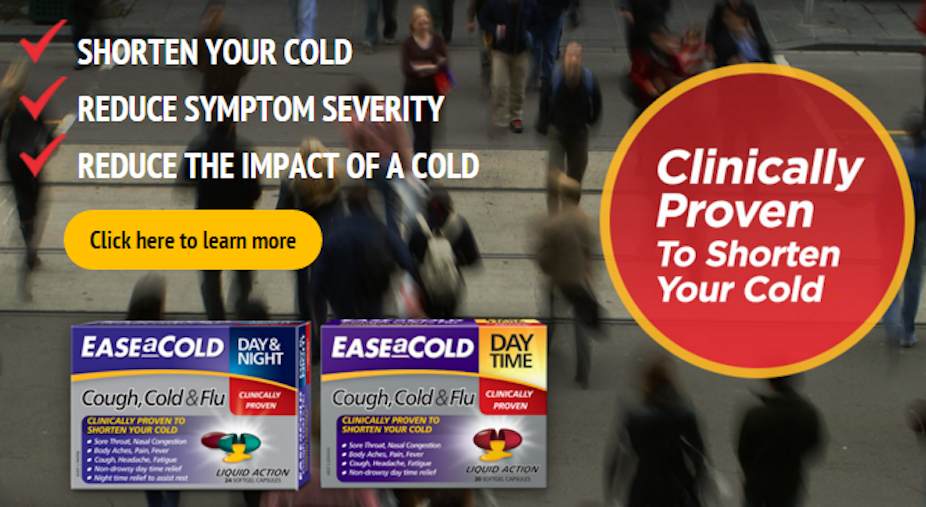We recently submitted a complaint about the promotion of Ease-a-Cold products, which claim to be “clinically proven” to shorten your cold. The complaint highlights a number of long-standing problems with the regulation of complementary medicines.
The results of the Ease-a-Cold trial mentioned in the ads are unpublished and unavailable. And the ingredients used in the trial also appear to be different to those in the products promoted. This casts doubt on the relevance of the trial to the claims made, regardless of the results.
Even if our complaint is upheld, it can take years before misleading and deceptive claims are removed. The Federal Court finally ordered Reckitt Benckiser to remove its pain-specific Nurofen products from the shelves because of misleading claims. But this occurred four years after the first complaint.
What’s wrong with the current system?
The current system is based on trust. Australia’s medicines regulator, the Therapeutic Goods Administration (TGA), does not assess the claims of the vast majority of complementary medicines (labelled AUST L) before they go to market. Rather, the company simply promises that it holds evidence to support any health claims it makes.
Companies also promise that the product only contains ingredients the TGA regards as relatively safe and that production follows good manufacturing practice.
The TGA only occasionally checks if the companies’ promises can be confirmed by post-marketing reviews. In the last six months of 2014, the TGA listed 1022 new products but only initiated 72 post-marketing reviews. In the same period, 60% of reviews found manufacturers weren’t compliant.
Each year, more than 100 complaints sent to the Therapeutic Goods Advertising Complaint Resolution Panel (TGACRP) are upheld. But the TGACRP and the TGA lack the power to adequately respond: they can’t issue substantial fines or order manufacturers to take out corrective advertisements. So there is little to deter companies from making misleading claims.
Blueprint for change
Last week, industry, consumers and health care professionals met to respond to an independent review of the current regulatory system.
There was general agreement that the current system is broken. The market is flooded with more than 12,000 products for which the claims made are rarely supported by the evidence available.
Consumers are put at risk because they are unable to make an informed choice about the benefits and risks of complementary medicines.
Companies currently get a better return from investing in promotional hype and celebrity endorsement, rather than research aimed at new innovative products.
The review panel proposed an integrated package of measures to fix these problems.
First, it recommends eliminating the free text option in the listing process that allows companies to creatively add their own product indications such as CoQ10, “supports a healthy cardiovascular system”, and probiotics, “help improve general well-being”.
Instead, the TGA should establish a limited list of evidence-based “permitted indications” which companies can use. An example might be, “glucosamine sulphate may relieve joint pain”.
Second, the review panel wants companies to publish the evidence they hold to support the indications made. And where the company has made its own assessment of the evidence for their product, the panel wants a prominent disclaimer to be added to all promotional materials that states: “efficacy claims for the product have not been independently assessed”.
Third, the panel recommends increasing the number of post-marketing reviews and making them more transparent; and that the complaint process be revamped and current investigative and enforcement powers be broadened.
To encourage research and innovation, the review panel recommends the TGA provide a new listing pathway, which would allow companies to submit clinical trial data to the TGA to get a higher level claim approved. An example might be, “clinical trials show that DONA® glucosamine sulphate provides symptomatic relief of osteoarthritis”.
This would be a less rigorous path than product registration. It would also allow a company to claim that the efficacy of its product had been independently assessed for that particular use.
Hurdles to overcome
The industry is concerned that eliminating the free text option will limit its ability to differentiate competing products in the marketplace. It is also concerned that requiring companies to publish the evidence supporting an indication would allow free-loading by copy-cat competitors.
However, we agree with the World Health Organisation and others that all clinical trial results should be in the public domain.
Finally, a number of the failings of the current system have resulted from inadequate resourcing of the TGACRP and the TGA. This has been noted in most of the 16 consultations and inquiries since 2002. The benefits from revamping the system will only eventuate if greater resources are committed.
So what happens next?
The Department of Health will soon deliver its recommendations to health ministers Sussan Ley and Fiona Nash. Their response presents an historic opportunity for the government to show that Australia leads the world in complementary medicine regulation and consumer protection, industry innovation and export opportunities.

